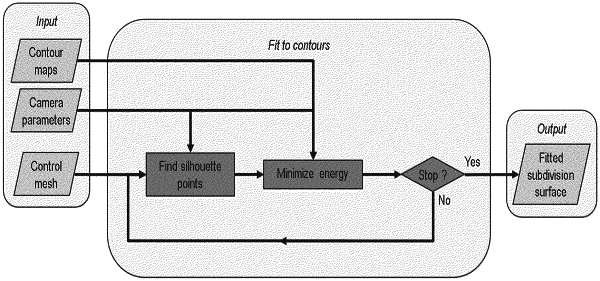| CPC G06T 17/20 (2013.01) [G06F 30/17 (2020.01); G06F 30/23 (2020.01); G06T 5/002 (2013.01)] | 16 Claims |

|
1. A computer-implemented method for 3D reconstruction, the method comprising:
obtaining 2D images which all represent a same real object which is fixed, and, for each 2D image, camera parameters which define a perspective projection;
obtaining, for each 2D image, a smooth map, the smooth map having pixel values each representing a measurement of contour presence, the contour being a location of separation between two different textures of the 2D image, the smooth map including local extrema corresponding to contour probability maxima, an energy rewarding high contour probability at projections of silhouette vertices, the smooth map varying from values representing a respective zero contour probability to the local extrema, the smooth map having non-zero gradients at least in a vicinity of image contours, a gradient of the smooth map being thereby non-zero at pixels corresponding to zero contour probability, the smooth map locally varying monotonously towards local optima and presenting C0 continuity; and
determining a 3D modeled object that represents the real object, the 3D modeled object being a control mesh of a subdivision surface, the control mesh being determined from an initial dense mesh approximating the real object, the determining iteratively optimizing energy that rewards, for each smooth map, projections of silhouette vertices of the 3D modeled object having pixel values, on the smooth map, representing a high measurement of contour presence, the optimization iteratively following a monotonous gradient path on the smooth map,
wherein the method further comprises, at each iteration of the optimizing:
obtaining a current first mesh, which is a control mesh;
obtaining a current second mesh, the current second mesh being obtained by subdividing the current first mesh;
for each 2D image:
projecting the current second mesh on the 2D image;
computing a 2D silhouette of the 3D modeled object in the 2D image; and
identifying points of the current second mesh corresponding to the 2D silhouette, as the silhouette vertices; and
modifying the current first mesh to reduce the energy, the modified current first mesh of each respective iteration having a next iteration being the current first mesh of the next iteration, the current second mesh of the next iteration thereby having different coordinates of vertices from the current second mesh of the respective iteration.
|